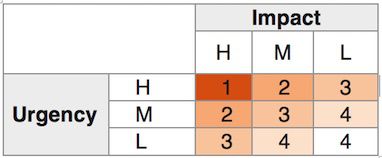How to assign the right priority to a ticket
The Priority is the result of Impact + Urgency.
1. Incident Impact (Impact Categories)
This section introduces Incident Impact categories. The definitions must be exactly matched to the organisation, so the following table is an example:
|
Category |
Description |
|
High (H) Widespread |
▪ A large number of employees are affected and / or can’t perform their duties.
|
|
Medium (M) Localized |
▪ A moderate number of employees are affected and / or can’t perform their tasks as intended.
|
|
Low (L) Individualized |
▪ A minimal number of employees are affected and / or can perform their tasks, but only with additional effort.
|
2. Incident Urgency (Urgency Categories)
This section provides Incident-Urgency categories. The definitions must be exactly matched to the organisation, so the following table is an example:
|
Category |
Description |
|
High (H) |
▪ The damage caused by the incident increases rapidly.
|
|
Medium (M) |
▪ The damage caused by the Incident increases substantially over time.
|
|
Low (L) |
▪ The damage caused by the Incident increases only slightly in the course of time.
|
3. Incident Priority also known as Severity Level
The Priority will be made dependent on Impact + Urgency.
For example a
High Impact + High Urgency will result in a Critical ticket priority or a
High Impact + Medium Urgency will result in a High ticket priority
according to the following data lookup rules:
H – High M – Medium L – Low
* Result in Censhare Ticket:
Priority 1 = Critical = Production Critical
Priority 2 = High = Workaround possible
Priority 3 = Medium = Function Limited
Priority 4 = Low = Uncritical
.png)
